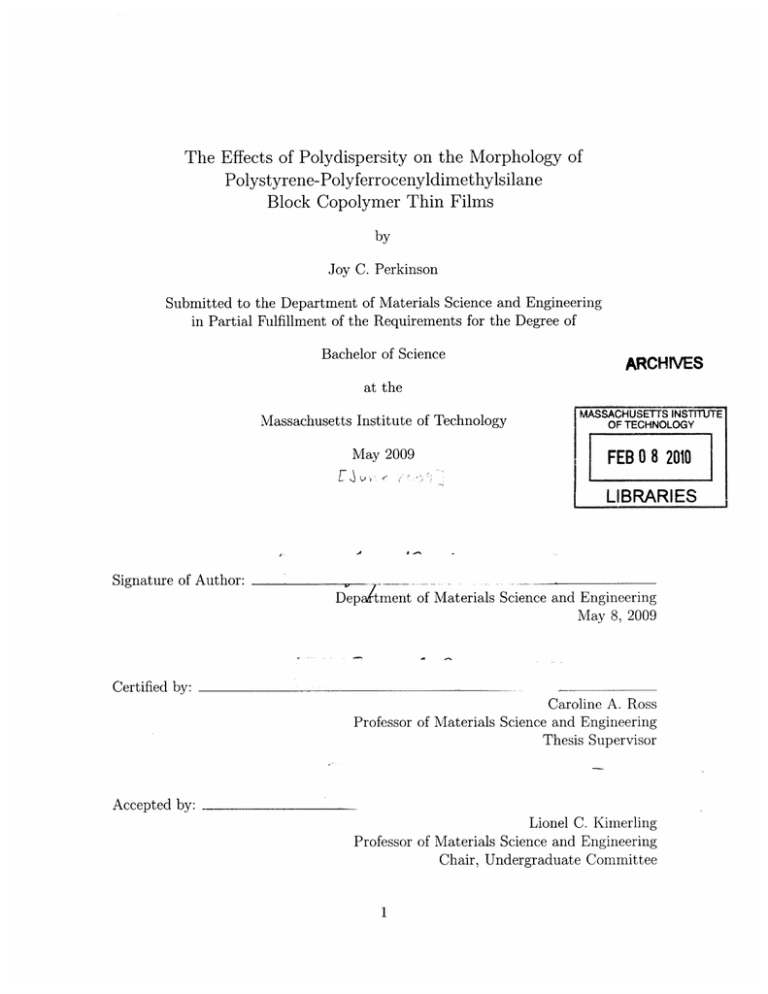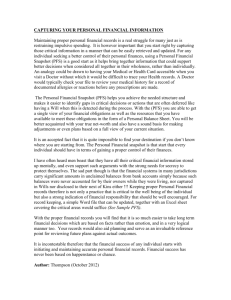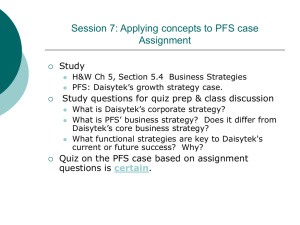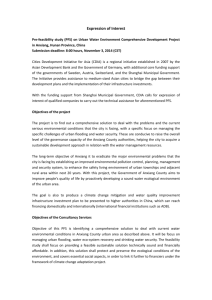The Effects of Polydispersity on the ... Polystyrene-Polyferrocenyldimethylsilane Block Copolymer Thin Films
advertisement

The Effects of Polydispersity on the Morphology of
Polystyrene-Polyferrocenyldimethylsilane
Block Copolymer Thin Films
by
Joy C. Perkinson
Submitted to the Department of Materials Science and Engineering
in Partial Fulfillment of the Requirements for the Degree of
Bachelor of Science
ARCHIVES
at the
Massachusetts Institute of Technology
May 2009
MASSACHUSETS INS
OF TECHNOLOGY
FEB 0 8 2010
LIBRARIES
A
A.
Signature of Author:
Depatment of Materials Science and Engineering
May 8, 2009
Certified by:
Caroline A. Ross
Professor of Materials Science and Engineering
Thesis Supervisor
Accepted by:
Lionel C. Kimerling
Professor of Materials Science and Engineering
Chair, Undergraduate Committee
irE
Acknowledgements
I would like to deeply thank my advisor, Professor Caroline A. Ross, for accepting
me into her research group for three consecutive years, and for acting as a mentor
throughout my studies of magnetism and polymers. Without her guidance, this thesis
would not have been written.
I would like to thank Vivian Peng-Wei Chuang and Filip Ilievski for teaching me
how to conduct research in a laboratory setting. They taught me the techniques that
made my research possible.
I would like to thank MIT, my alma mater, for teaching me the skills to work
under pressure. The abilities that MIT has granted me will last a lifetime. They
ensured I kept a level head throughout the week before this thesis was due.
I would like to thank the MIT Assassins' Guild and American Jiu Jitsu for keeping
my head clear.
I would like to thank all mentors and role models who have helped me along my
way. In particular, and in order of appearance: Annabeth Jensen, Robert Salazar,
Jeffrey Payne, Art Leo, Arthur Glasfeld, Peter Child, and Berit Johannes. Whether
or not you know it, you have all inspired me to make more of myself.
Most of all, I would like to give my sincerest thank you to my family, as well as
to VKC and SJW, for supporting me throughout my time at MIT. You have made
me who I am today.
To all listed above: live long and prosper.
Contents
1 Introduction
1.1 Motivation ...................
1.2 Purpose ...................
.
.............
................
11
2 Experimental Procedure
3 Results and Discussion
3.1 Volume Fraction. ...................
3.2 Thickness ...................
3.3 Annealing Time ...........
3.4 Molecular Weight .......
3.5 Polydispersity ...................
4
4
4
9
..
...
...
. ........
...........
.......
.....
......
.....
.......
....
..
14
14
17
19
20
21
24
Conclusion
A Polymer Fabrication Methods
25
B MATLAB Code
B.1 Area Data ......
B.2 Distance Data ......
B.3 Pair Density Function
27
27
29
32
References
......
..........
...................
..
.........
.............
......
.......
35
-~
--
1
1.1
Introduction
Motivation
As the size of electronic and magnetic devices decreases, nanoscale patterning becomes an increasingly important area of research. Two different approaches have
been taken to pattern media: top-down methods such as lithography, and bottom-up
methods such as self-assembly. Top-down assembly methods have the advantages of
precision and accuracy, but are hard to scale for certain industrial applications due
to their low throughput. Self-assembly methods are more easily scalable for applications requiring mass production. Thus, self-assembly has attracted attention and
is an area of ongoing research for its potential to create high-throughput, periodic
nanoscale patterns.
Block copolymers are a class of commonly-studied materials for nanoscale selfassembly. Block copolymers are long molecules that consist of "blocks" of chemically
differing polymers attached end-to-end. Under the right conditions, these blocks will
phase separate, spontaneously forming periodic microdomains. Diblock copolymers,
which have only two blocks, have been found to form a variety of well-ordered morphologies with nanoscale periodicity (Figure 1) [1].
B
Spheres
B
Cylinders
B
Double Gyroid
B
Lamellae
Figure 1: The ordered structures formed by diblock copolymers [2].
Nanoscale patterning is of particular interest for use in high-density magnetic data
storage. Thin films of diblock copolymers can serve as self-assembled templates for
patterning magnetic materials [3]. The morphology of block copolymers is generally
predicted using a XN diagram. These diagrams plot the dependence of phase transitions on polymer volume fraction and the value XN (Figure 2) [1]. In these diagrams,
120
100
Q
O
80
L
H
H
XN 60
40
20
0IS
0
0.2
0.4
f
0.8
06
1
Figure 2: The generic XN diagram for block copolymer systems, showing the dependence of phase transitions and the order-disorder transition on volume fraction and
the XN value of the system. In this diagram, CPS is the order-disorder transition,
QlIm3 m is the spherical regime, H is the cylindrical regime, Qla3a is the double gyroid
regime, and L is the lamellar regime [4].
volume fraction is on the horizontal axis, and XN is on the vertical axis. N refers to
the degree of polymerization of the entire chain, and X is the Flory-Huggins interaction parameter used to describe the enthalpic interactions between the two blocks.
The full expression for X is:
X12
kT(E12 -
(11
±
22
))
where z is the number of adjacent lattice sites used in the Flory-Huggins derivation
of free energy, kBT is the thermal energy, and the e terms are the interaction energies
between the two species present in diblock copolymer systems. Interaction energies
are negative, with more negative indicating a more enthalpically favorable interaction.
Thus, a positive value of X indicates unfavorable enthalpic interactions between the
two blocks, and thus a tendency for the blocks to phase separate. A negative value of
X indicates favorable interactions between the two blocks. This expression has been
simplified for the PS/PFS system [5]:
x(T) = 0.028 + 3.28/T
This equation takes into account the interaction energies between the PS and PFS
blocks. T is the annealing temperature in Kelvin. XN can thus be calculated for the
samples in this study given the annealing temperature and degree of polymerization of
the samples. This value can be used to predict the morphology of diblock copolymer
thin films.
Once the desired morphology has been attained, the block copolymers can serve
as lithographic masks. These masks can be used to etch into magnetic materials
to create periodic magnetic nanoparticles to be used as bits for data storage. The
spherical morphology block copolymers researched in this study exhibit periodicity
around 30nm, which would pack data at around i x 1013 particles/in 2 , over a terabyte
of information per square inch. This amount of information density, along with the
high throughput of self-assembly methods, makes block copolymers an attractive
choice for nanoscale patterning of high-density magnetic data storage devices as well
as other electronic, optic, and magnetic devices.
One of the limitations of using thin polymer films as lithographic masks is their
relatively high etch rate, in comparison to magnetic materials, during reactive ion
etching (RIE). RIE is a form of plasma etching used to selectively remove materials
or to transfer patterns. When used for transferring patterns from a polymer film
into a substrate, RIE needs to etch the material below the polymer film before the
polymer is etched away completely. Some magnetic materials used for data storage
applications, such as cobalt and nickel, cannot be etched by RIE but require ion
beam etching. Thus, attempting to transfer the pattern directly from a polymer
film to a cobalt film would etch away the polymer without affecting the cobalt layer.
However, this problem can be solved using a combination of more complex processing
methods and organometallic polymers, which are highly etch-resistant. When organicorganometallic block copolymers are used in thin films, the organic block can be easily
etched away, leaving the organometallic structures for use in pattern transfer [6]. By
designing block copolymers with organometallic materials as the minority block, one
can create highly etch-resistant organometallic spheres within an organic matrix that
can be easily removed via RIE [7]. In this way, one can create lithographic masks
with periodic spherical morphology that is etch-resistant enough to be used in the
processing for magnetic data storage applications.
The organic-organometallic block copolymer used in this study is polystyreneblock-polyferrocenyldimethylsilane(PS-b-PFS) (Figure 3) [8]. At the volume fractions
-~H
Fe
n-Bu--CH 2-CH
Si
Me
-m
Figure 3: The chemical structure of polystyrene-block-polyferrocenyldimethylsilane
[9].
investigated, the organometallic PFS block forms mostly spheres, though cylinders
i
are occasionally observed. The PFS spheres sit within a matrix of PS, and a brush
layer of PFS forms atop the silicon substrate (Figure 4). The number of layers of
30 ~ 60 nm
...........................
....
..
15 ~35 nm
Sphere
PShnamt
lyer ofPbu
o
rBP.ad
u
bsr a
T
Figure 4: A side view of the PS/PFS thin film morphology. PFS forms spheres
within a matrix of PFS, and a brush layer of PFS forms atop the substrate. The
number of layers of PFS spheres can be controlled by adjusting the film thickness
[10].
PFS spheres can be controlled by adjusting the thickness of the polymer film, though
for pattern transfer applications, a monolayer is ideal.
While PFS spheres are relatively etch-resistant for a polymer, they are still not
able to resist ion beam etching long enough to transfer a pattern directly into a
magnetic material. A method was devised to circumvent this problem by transferring
the pattern into increasingly etch-resistant materials [3]. In this method, the PS/PFS
film is deposited onto a layered stack. The PS is etched away, and the PFS is used
as a mask to transfer the pattern into the top layer, silicon dioxide, via RIE. This
pattern is then etched with RIE into the next layer, tungsten. Layers are etched down
with RIE and ashing until only a periodic array of tungsten dots remains above the
-i
I
magnetic layer. Finally, the pattern is transferred to a magnetic material, such as
cobalt, via ion beam etching (Figure 4). The resulting nanoparticles can be used as
(a)
PFS PS
*d*
CF O RIE
Si
(c)
CHF3RIE
Etching
Figure 4: The layer-by-layer pattern transfer method. A PS/PFS film is deposited on
a layered substrate. Layers are etched through via RIE, ashing, and ion beam etching,
and the pattern is eventually transfered into a layer of cobalt, creating magnetic
nanodots [3].
bits in high-density data storage.
1.2
Purpose
In order to effectively use self-assembled structures as templates for data storage
devices, both the spacing and size of surface features must be uniform. Extensive
research has been done to control the packing of polymer spheres and to remove the
"grain boundaries" that can form in packed sphere structures using templated selfassembly methods to induce ordering by topographical and/or chemical patterns [10].
However, some discussions of sphere uniformity blame poor uniformity on polydispersity effects [11, 12].
Polydispersity is quantified using the polydispersity index (PDI), which is defined
as
PDI = Mw/M
where Mw is the weight average molar mass of the polymer and M" is the number
average molar mass of the polymer:
Mw = E NM1/ E NiM
Mn =
Z NM/
N
Weight-average molar mass
Number-average molar mass
In these expressions, Ni is the number of molecules with given molar mass Mi. By
definition, Mw > Mn, so the minimum PDI of any polymer sample is PDI = 1.
This value indicates perfect uniformity, in which all molecules have exactly the same
molecular weight. High PDI values indicate a wide range of molecular weights within
a sample.
This study aims to determine the extent to which PDI affects the morphology of
PFS microdomains. Five PS/PFS block copolymers were prepared by collaborators
at University Twente in the Netherlands, each with a different PDI between 1.109
and 1.198. However, the polymers also varied in molecular weight and PFS volume
fraction. Thus, the end result of this research is a discussion of the relative effects
of varying PDI, volume fraction, and molecular weight at the same time. Sample
annealing time and film thickness effects are also discussed.
2
Experimental Procedure
Polymers with varying PDI, molecular weight, and PFS volume fraction were fabricated by collaborators at University Twente (Table 1). Their methods of fabrication
Table 1: Physical properties of the five PS/PFS samples studied. (I indicates volume
fraction.
Sample
A
B
C
D
E
) PFS
vol %
19
17
22
20
13
MWtotal
MWps
MWPFS
PDI
(g/mol)
54125
48282
47127
51202
50529
(g/mol)
42597
38639
35098
39501
42113
(g/mol)
11866
9445
11866
12060
7502
1.109
1.114
1.123
1.188
1.198
are included as Appendix A [13].
To prepare the polymers for deposition on a substrate, 1.5wt% solutions of PS/PFS
in toluene were created. The solutions were left to sit for at least 2 hours to allow the
polymer to dissolve and ensure a homogeneous solution. Then, prime silicon wafer
was cut into pieces around a square centimeter in size. These pieces of silicon were
cleaned with a nitrogen gun in MIT's NanoStructures Laboratory (NSL) cleanroom
facilities. Then, polymer solution was deposited onto the wafer pieces via spin coating. The speed of the spin coater was set prior to polymer deposition, to ensure
reproducible results. Samples were spun for 60 seconds at a range of spin speeds.
Film thickness was controlled by adjusting the spin speed, with higher speeds corresponding to thinner films. Spin speeds ranging from 1500 to 6000 RPM corresponded
to film thicknesses between 32 and 63nm. For samples not specifically investigating
the effects of film thickness, films around 42nm were used, created at a spin speed of
3000 RPM. This thickness was chosen because it corresponded to a single monolayer
of PFS microdomains for all five polymers.
Deposited films were taken to CMSE facilities for annealing. Samples were annealed at 140 0 C (413 K) in a vacuum furnace. This temperature is above the glass
transition temperature for both PS and PFS, so their mobility was substantially increased during annealing. This allowed the block copolymers to rearrange into organized, periodic arrays. Most samples were annealed for 24-30 hours, though annealing
times from 1 to 7 days were investigated. The ovens were then vented with nitrogen gas, and samples were transported back to NSL cleanroom facilities for imaging.
Before imaging, RIE was used to run a 25-second oxygen plasma etch at 90W. This
step removed the top layer of PS matrix so PFS features could be observed. Finally,
samples were imaged using scanning probe microscopy (SEM).
Properties of the PFS features observed in the SEM images were analyzed using
image processing and MATLAB software. The PFS microdomains were targeted using
a threshold overlay in SigmaScan, an image analysis program, and their areas and
coordinates were recorded. MATLAB scripts (Appendix B) were used to calculate
object areas, calculate distances between objects, and create pair density functions
(PDFs) for each sample. Together, the scripts calculated the mean and standard
deviation for both the area of PFS microdomains and the distance between them.
The PDF, g(r), is a dimensionless measure of the density of objects around a point,
and is defined as
1 dn(r,r+dr)
p dA(r,r+dr)
where p is the areal particle density, dn is the number of pairs of particles between
a radial distance r and r + dr, and dA is the area contained between r and r +
dr. Periodic PDFs that decay quickly indicate short range order (Figure 6), while
periodic PDFs that do not decay over a large distance indicate long-range order.
The correlation length, (, was determined by recording the distance at which the
PDF of PS/PFS 1.109
01
0
/
-
I
50
I
100
I
150
I
200
Distance (nm)
Figure 6: A pair density function for PS/PFS with PDI 1.109 and thickness 42nm.
The decaying oscillations indicate short range order.
amplitude of PDF oscillations fell below 5% of the peak amplitude.
I
-
3
3.1
-- F-
I
cC I
C
IP
Results and Discussion
Volume Fraction
Volume fraction was found to have a significant impact on the observed morphology
of the PS/PFS films. At low volume fractions (4DPFS = 13%), the PFS microdomains
are small and irregular. At mid-range volume fractions
(4DPFS =
17 - 19%), the PFS
microdomains are regular spheres. At higher volume fractions (J PFS = 20 - 22%),
PFS cylinders begin to form in the matrix of spheres (Figure 7). The emergence of
Figure 7: The effects of volume fraction on PS/PFS films with thickness 42nm. PFS
volume fractions are (A) 19%, (B) 17%, (C) 22%, (D) 20%, and (E) 13%. Lettering
corresponds to the sample lettering from Table 1. Sample E, with PFS volume fraction
of q = 13%, is near the order-disorder transition, and is thus irregular. Samples A
and B are in the spherical phase. Cylinders begin appearing in sample D, with
0 = 20%. In sample C, with 0 = 22%, many cylinders are visible. These transitions
are consistent with the xN diagram describing diblock copolmyer morphology.
cylinders at
(PFS
= 20% is similar to results from previous work [3, 14].
As revealed by comparing the volume fractions of samples A-E (Table 1) with the
--
calculated data for those samples (Table 2), there is a strong correlation between volTable 2: Data on the 42nm-thick films of the five PS/PFS samples.
Sample
A
B
C
D
E
4 PFS
vol %
19
17
22
20
13
Area (nm)
Mean Std. Dev
44.9
249.8
47.7
222.5
381.2
447.1
104.9
290.7
47.3
117.8
Distance (nm)
Mean Std. Dev
3.1
29.5
2.9
26.4
3.2
30.3
29.0
3.3
4.5
22.7
(nm)
171
141
135
195
120
ume fraction and both the mean area of PFS features and the mean distance between
them. The trend of increasing mean area values corresponds directly to increasing
volume fraction. This is also true of mean distance values, with the minor exception
of mean distances 29.0 and 29.5nm corresponding to 20 and 19% PFS instead of the
other way around. These data are consistent with the emergence of spheres and then
cylinders as PFS volume fraction increases, as these regime changes increase both
the area of PFS microdomains and the distance between them. The sample with the
lowest volume fraction, 13%, exhibits the lowest mean area, lowest mean distance,
and largest standard distance deviation of any of the samples, corresponding to the
small and irregularly-shaped PFS microdomains in the sample. The sample with the
highest volume fraction, 22%, exhibits the highest mean area, standard area deviation, and mean distance between PFS microdomains of any sample, indicating the
presence of large cylinders. These two samples also exhibit the lowest correlation
lengths of any samples, indicating that they are furthest from the uniform spherical
domain. This result can be verified by observing SEM images of the films (Figure 7).
The sphere-to-cylinder (S/C) transition is generally predicted using the xN diagram. We can calculate the xN value of our samples using the annealing temperature and degree of polymerization. X depends on the annealing temperature, which
is 1400C (410 K) for these samples.
XPS/PFS(T) = 0.028 + 3.28/T
XPS/PFS(410) = 0.028 + 3.28/410
= 0.036
We can calculate the degree of polymerization N for our polymers using the molecular weight of the blocks and the molar masses of the monomers. Through these
calculations, it is found that the average degree of polymerization for the polymers is
N = 422.4. xN is therefore 16.6 for our polymers.
This value can be used to compare the observed morphology of the PS/PFS samples to the morphology predicted by the xN diagram in Figure 2. The xN diagram
predicts that samples with a xN value of 16.6 will exhibit a S/C transition at approximately 28% PFS. While no samples in this study have volume fractions large enough
to observe a complete transition into the cylindrical domain, the emergence of short
cylinders at 20% PFS and the mix of spheres and cylinders at 22% PFS suggest that
a complete S/C transition will occur close to 28% PFS.
However, the xN diagram also predicts that a volume fraction of 13% PFS in a
sample with a xN value of 16.6 will be disordered. This prediction is significantly
different than the observed morphology of PFS microdomains at that volume fraction.
While the microdomains in the sample with volume fraction 13% are less ordered than
the microdomains observed at higher volume fractions, PS/PFS phase separation is
observed. This result can be explained by the fact that the generic XN diagram is
designed for bulk systems, not for thin films. The phase behavior of thin films is
different than that of bulk block copolymers due to a variety of factors, such as the
preferential interaction of different blocks with the substrate. Surface energy terms,
which are more pronounced in thin films, could also affect the phase behavior of the
system.
3.2
Thickness
Six film thicknesses were investigated for sample A, ranging from 36.1 to 62.2nm. A
significant change in properties occurred between 45.0 and 48.9nm (Table 3). The
Table 3: Properties of PS/PFS films with varying thickness. A significant change in
properties is observed between 45.0 and 48.9nm, corresponding to the formation of a
second layer of PFS spheres above 45nm.
Thickness
(nm)
62.2
53.7
48.9
45.0
39.3
36.1
Area (nm)
Mean Std. Dev
81.7
223.5
221.4
69.1
213.7
57.3
274.0
47.1
68.4
265.1
72.1
260.7
Distance (nm)
Mean Std. Dev
3.6
29.8
3.6
29.4
3.3
28.8
2.7
29.8
3.4
31.2
3.7
31.5
(nm)
165
138
162
195
189
162
mean area of PFS microdomains increased sharply, from 213.7 to 274.0nm. This
change can be attributed to the formation of a second layer of PFS features at thicknesses greater than 45nm. Below 45nm, there is a monolayer of PFS spheres, in
addition to the brush layer of PFS at the substrate. Above 45nm, a bilayer of PFS
spheres can be seen (Figure 8). The data exhibit some correlation with the two thickness regimes. The mean area of PFS microdomains in the bilayer is between 213.7
and 223.5nm, while the mean area in the monolayer is between 260.7 and 274.0nm.
Within these regimes, data indicate that mean area decreases slightly as film thickness decreases. However, the mean area variation within the bilayer regime exhibits
a variation of only 4.6% of the total microdomain area, while the variation within the
monolayer regime exhibits a variation of only 5.1%. These variations are small
L
3
L
Figure 8: The effects of film thickness on PFS microdomains. Thicknesses are (1)
62.2nm, (2) 53.7nm, (3) 48.9nm, (4) 45.0nm, (5) 39.3nm, and (6) 36.1nm. Two layers
of PFS spheres are visible above 45nm. At 45nm and below, a monolayer is observed.
18
enough that they could be within the range of experimental error. The existence
of two thickness regimes is reflected in the other data as well. The mean distance
between PFS microdomains is generally larger in the monolayer samples, and the
standard deviation of both mean area and distance is generally smaller. Furthermore, the correlation lengths of the monolayer samples are larger than those of the
bilayer. Together, these results indicate that monolayer films of PFS spheres exhibit
greater uniformity, longer-range order, and greater spacing between microdomains
than bilayer films. These results reflect the greater conformational entropy present
in systems with multiple layers of spheres.
3.3
Annealing Time
The effects of annealing time were investigated for a film of sample A. Samples were
annealed at 140'C for 1, 2, 4, and 7 days (Figure 9). The films showed increased
uniformity as annealing time increased (Table 4). The sample annealed for 1 day
Table 4: Properties of films with varying annealing times, made from 42nm thick
PS/PFS sample A with PDI 1.109.
Annealing
time (days)
1
2
4
7
Area (nm)
Mean Std. Dev
247
61.6
245
66.5
273
48.6
274
44.0
Distance (nm)
Mean Std. Dev
26.1
8.4
8.7
26.2
29.8
3.0
29.8
2.6
(nm)
135
198
156
198
contained some PFS cylinders, the sample annealed for 2 days contained fewer, and
by 4 days of annealing, no more were observed and the PFS spheres were spaced
evenly.
Though some changes were observed with annealing time, the changes were small.
-
Figure 9: The effects of annealing time on PS/PFS films with thickness 42nm.
Samples were annealed at 140 0 C for (Al) 1 day, (A2) 2 day, (A4) 4 day, (A7) 7 days.
However, the large increase in correlation length between the first and second days
of annealing, from 135 to 198nm, indicates increased uniformity after the first day of
annealing. Furthermore, the absence of cylinders at longer annealing times qualitatively indicates that most of the self-organizing occurs within the first two days of
annealing.
3.4
Molecular Weight
The total polymer molecular weight was not found to correlate strongly with the
observed structure of the films (Tables 1, 2). However, increased molecular weight
should increase the mean area of microdomains and the distance between them. For
L
the samples in this study, the effects of molecular weight could be outweighed by the
effects of volume fraction. Samples A and D have similar volume fraction, and thus
provide the best opportunity for examination of molecular weight effects. Sample A
has PFS volume fraction 19%, while sample D has PFS volume fraction 20%. Based on
volume fraction effects alone, sample D should exhibit greater mean area and distance,
and greater standard deviation. However, sample A has a higher molecular weight
than sample D. The samples have a total molecular weight of 54125 and 51202 g/mol,
respectively. While the mean PFS microdomain area, standard area deviation, and
standard distance deviation of sample D are greater than that of sample A, sample D
exhibits a lower mean distance between microdomains than sample A. While the mean
distance values are very close together, at 29.5 and 29.0nm respectively, these values
are the only discrepancy in a mean area and distance trend that strictly increases
with volume fraction. The discrepancy could be due to larger molecules increasing
the spacing between PFS microdomains.
Other than this small discrepancy in mean distance data, no correlation is observed
between the data and molecular weight. However, larger molecules should increase
the area of microdomains and the spacing between them. It is expected that if a
wider range of molecular weights were represented in the the study, molecular weight
effects on morphology would be observed.
3.5
Polydispersity
The PDI was found to have no noticeable effect on the observed morphology (Tables
1, 2). While PDI has been used to justify variations in morphology in some studies
[11, 12], this study shows no correlation between changes in PDI and surface features. Samples A, C, and E have PDI 1.109, 1.123, and 1.198 respectively. However,
the mean area of the PFS microdomains in sample A is 249.8nm, which increases to
447.1nm for sample C, and then decreases to 117.8nm for sample E. The standard
area deviation of these three samples are 44.9, 381.2, and 47.3nm, respectively. The
mean distance between PFS microdomains for the samples are 29.5, 30.3, and 22.7nm,
respectively. Though samples A, C, and E span the range of polydispersities investigated in this study, they exhibit no trend for mean area, mean distance, or standard
area deviation. Similarly, the correlation length for the sample with PDI 1.109 is
171nm, which increases to 195nm for the sample with PDI 1.188, and decreases to
120nm for the sample with PDI 1.198. The only observed trend is in the standard distance deviation. Overall, the standard deviation of distances between microdomains
increases with PDI. However, the variance is small. The standard distance deviations
of the samples with PDI 1.109, 1.114, 1.123, and 1.188 vary only by tenths, a change
of less than 5% the total standard deviation value. Additionally, the sample with
PDI 1.114 contradicts this trend by exhibiting the lowest standard distance deviation
while not having the lowest PDI. Thus, the only observed trend is relatively weak.
These results can be explained by considering the number of chains in each PFS
microdomain. The density of PFS is 1.26 g/cm3 (Appendix A). PFS spheres have
a cross-sectional area around 250nm 2 , corresponding to a radius of 8.92nm, and a
total sphere volume of 2.97pm. Combining the PFS density and the sphere volume,
and using an approximate molar weight of 10,000g/mol for the PFS block, the total
number of chain ends per sphere is
2.97 x 10-8cm
3
1.26g
cm
1mol
10,00g
6.022x 1023 chains
mol
224 chains/sphere
224
If this calculation is repeated twice, once using conservative estimates of all the quantities and once using generous estimates, the range of values for the number of chains
per sphere is
144 < chains
< 424
sphere
For a microdomain with N chains, the average variation in number of chains
goes as
N. Thus, an average variation of ± 15 chains per sphere is expected for
the PFS microdomains in this study. Using the generous and conservative estimates
of the number of chains per sphere, the expected variation in number of chains per
microdomain is calculated between 12 and 21 PFS chains. For the mid-range estimate,
the expected variation is a 7% change. This value is low enough that the effects of
variations in the number of chains per sphere are not easily observable.
For this
reason, the variations in PDI do not correlate with observed properties of the films.
4
Conclusion
Thin films of organic-organometallic block copolymers such as polystyrene-blockpolyferrocenyldimethylsilane (PS/PFS) have been investigated as self-assembled lithographic masks for nanoscale patterning of highly etch-resistant magnetic materials.
For magnetic data storage applications, microdomain uniformity is required in order
for data to be easily read and written. This study examined the relative importance
of five polymer properties on the morphology of PS/PFS thin films. In particular,
this study investigated the effects of polydispersity (PDI), which has been cited as
having a significant effect on block copolymer morphology.
The effects of varying volume fraction, film thickness, annealing time, molecular
weight, and PDI were investigated in terms of mean PFS microdomain area, standard
deviation of area, mean distance between PFS microdomains, standard deviation of
distance, and correlation length, as well as qualitative analysis of SEM images. Of
the polymer properties, volume fraction was found to have the greatest effect on
PS/PFS morphology. This result can be explained by the XN phase diagram for
block copolymer morphology. Thickness variations were found to cause a significant
change in mean microdomain area during the transition from a PFS sphere monolayer
to a bilayer. Annealing time analysis revealed that samples reached equilibrium after
approximately 2 days of annealing. Molecular weight was found to have a negligible
effect on PS/PFS morphology. Finally, PDI was found to have no noticeable effect on
the morphology of PS/PFS microdomains. This result can be explained by calculating
that the average number of PFS chains per microdomain is 224, and the variance
between spheres is approximately 15, a change of only 7%. Thus, in relation to the
other polymer properties investigated in this study, PDI has a negligible effect on
PS/PFS thin film morphology.
A
Polymer Fabrication Methods
Written by Janet Acikgoz [13].
N,N,N',N',-Tetramethylethylenediamine(TMEDA), ferrocene, styrene, n-butyllithium
(1.6 M in hexanes), dibutylmagnesium (1.0 M in heptane) and dichlorodimethylsilane
were purchased from Aldrich.
[1]Dimethlysilaferrocenophane was prepared as de-
scribed earlier and was purified by sequential crystallization and vacuum sublimation
cycles [14, 15]. Crystallizations were performed at low temperature in n-heptane. Solutions of styrene in ethylbenzene were dried on dibutylmagnesium and distilled under
vacuum. n-Butyllithium was diluted to 0.2 M with n-heptane, which was dried over
n-butyllithium and distilled under vacuum. Tetrahydrofuran (THF) for anionic polymerizations was distilled from sodium-benzophenone under argon, degassed in three
freeze-pump-thaw cycles, and distilled by vacuum condensation from n-butyllithium
at low temperature.
Poly(styrene-block-ferrocenyldimethylsilane)copolymers were synthesized by sequential anionic polymerization carried out in an Mbraun Labmaster 130 glovebox
under an atmosphere of prepurified nitrogen (<0.1 ppm of H2 0). Polymerization of
styrene in ethylbenzene was initiated by n-butyllithium and stirred for 5 hours at room
temperature. After the styrene block formation was completed, [1]dimethlysilaferrocenophane was added to the solution followed by some THF, allowing the formation of
the organometallic block. After 2 hours, the living chains were terminated by adding
a few drops of degassed methanol. The polymers were precipitated in methanol and
dried under vacuum. Variation in polydispersity of the copolymers was achieved by
adding the required amount of initiator in several portions at different time intervals,
rather than at once.
The polymers were characterized by gel permeation chromatography (GPC) and
1H
NMR spectrometry. GPC measurements were carried out in THF using WatersTM
microstyragel columns with pore sizes of 105, 104 , 103 A and a 500 A guard column
(Waters). The instrument was equipped with a dual detection system consisting of
a differential refractometer (Waters model 410) and a viscometer (Viscotek model
H502). Molar masses were determined relative to narrow polystyrene standards.
1H
NMR spectra were recorded on a Varian Unity Inova (300 MHz) instrument at 300.3
MHz in deuterated chloroform. Block ratios were calculated from 1 H NMR peak
integrals. The density of poly(ferrocenyldimethylsilane), 1.26 g/cm3 , was obtained
using a pycnometer.
B
B.1
MATLAB Code
Area Data
Mean area and standard deviation were calculated using the MATLAB program
AreaHist. Inputs to the code were filename, the name of the data text file created
by SigmaScan, numbuckets, the number of buckets to include in the area data histogram, and PDI and rpm, the PDI of the polymer sample and the spin speed used.
The latter two inputs were used in the title of the area data histogram. Outputs of
the code were a histogram of area data (Figure B-1), and an output message of the
Area distribution of PS/PFS, PDI1.109,3000 spin speed
0L
100
150
200
250
300
350
400
2
Area (nm )
Figure B-1: A sample histogram of areas produced by the MATLAB script AreaHist.
These data were created for the sample with PDI 1.109, spin speed 3000, and film
thickness 43nm.
number of areas plotted, the mean area of all PFS microdomains in the sample, and
the standard deviation for the area data.
AreaHist was prepared with the help of Mark Mascaro [16], and the code is displayed below.
function areahistdata = AreaHist(filename, numbuckets, PDI, rpm)
file = fopen(filename);
unparsedarray = fscanf(file, '%f %f %f');
% First column of unparsedarray is areas
% Second and third columns are distances
N=1;
for i=1:(length(unparsedarray)/3)
for j=1:3
areaarray(i,j) = unparsedarray(N);
N = N + 1;
end
end
% Next, gather the areas
areahistdata = areaarray(:,1);
disp('Number of areas plotted: ')
disp(length(areahistdata))
[mean,stddev] = normfit(areahistdata);
disp('mean = '); disp(mean)
disp('std dev = '); disp(stddev)
hist(areahistdata,numbuckets);
title(strcat('Area distribution of PS/PFS', ',
' spin speed'));
xlabel('Area (nm^2)'); ylabel('Count');
PDI ',
PDI, ',
',
rpm,
B.2
Distance Data
Distance data were calculated using two programs in series, DistHist and Gauss.
DistHistcreates a histogram of the distances between all pairs of PFS microdomains
(Figure B-2a). This amount of data is difficult to visually process, but the axes can
be adjusted to zoom in on the histogram to view the first peak (Figure B-2b). The
distance that marks the end of the first peak must be recorded for use as an input to
the Gauss function. The output of DistHist is an array of the distance data plotted
in the histogram. This output must be stored as a local variable, for use in the Gauss
function.
Gauss calculates the mean distance and standard deviation between nearest neighbor PFS microdomains.
Gauss takes inputs distances, the data output from the
DistHistfunction, endofpeak, the distance at which the first peak of the distance histogram ended, PDI, the PDI of the sample, and rpm, the spin speed at which the
sample was created. The input endofpeak is important because, for nearest-neighbor
data, only the first peak from the distance histogram should be analyzed.
Gauss
displays a plot of the analyzed distance peak (Figure B-3) and prints the mean distance and standard deviation between nearest-neighbor PFS microdomains. Code for
DistHist and Gauss is shown below.
DistHist:
function disthistdata=PDF(filename, numbuckets, PDI, rpm)
file = fopen(filename);
unparseddistancearray = fscanf(file, '%f %f %f');
%First column of distancearray is areas;
% second column is x values,
%third column is y-values
N=1;
for i=l: (length(unparseddistancearray)/3)
for j=1:3
PDF of PS/PFS, PDI1.109,3000 spin speed
350
300
250
E
200
150
100
50
0
IIUU
4UU
Distance (nm)
PDF of PS/PFS, PDI1.109,3000 spin speed
300
250
200
150
C
100 F
0
0
1
10
20
Distance (nm)
Figure B-2: (a) A histogram of the distances between PFS microdomains in a sample
with PDI 1.109 and thickness 42nm, created by the MATLAB script DistHist. (b) A
closer view of the first peak, showing the end of the first peak at - 40nm. The value
for the end of the peak is an input for Gauss, the MATLAB function that calculates
the mean distance and standard deviation values used in this study.
Nearest-neighbor distance peak for PS/PFS, PDI1.109,3000 RPM
0.16
0.14
0.12
0.1
- 0.08
LL
0.06
0.04
0.02
0
-40
-30
-20
-10
0
Distance (nm)
10
20
30
40
Figure B-3: The nearest-neighbor distance peak plotted and analyzed by the MATLAB function Gauss. Gauss uses this peak to calculate the mean nearest-neighbor
distance and standard deviation.
distancearray(i,j) = unparseddistancearray(N);
N = N + 1;
end
end
%Gather the distances
datalength = length(distancearray(:, 1));
disthistdata = zeros(((datalength)^2 - datalength)/2,1);
N=1;
for i=1: (datalength-1)
for j=(i+l) :datalength
xdist = distancearray(i,2) - distancearray(j,2);
ydist = distancearray(i,3) - distancearray(j,3);
dist = sqrt(xdist.^2 + ydist.^2);
disthistdata(N) = dist;
N = N + 1;
end
end
% Plot
hist (disthistdata, numbuckets);
title(strcat('PDF of PS/PFS', ',
PDI ',
PDI,',
',
rpm,'
spin speed'));
xlabel('Distance (nm)'); ylabel('Count');
Gauss:
function Gauss(distances, endofpeak, PDI, rpm)
firstpeak = distances(find(distances<endofpeak));
[mean,stddev] = normfit(firstpeak);
disp('mean = '); disp(mean)
disp('std dev = ');
disp(stddev)
% Plot the Gaussian
xgrid = [stddev-(endofpeak-stddev):1:endofpeak];
plot(xgrid, normpdf(xgrid, mean, stddev),'black');
title(strcat('Nearest-neighbor distance peak for PS/PFS, PDI ',
', ',rpm,' RPM'));
PDI,.
xlabel 'Distance (nm)'
ylabel 'Frequency'
B.3
Pair Density Function
The pair density functions (PDFs) were generated using the MATLAB program PDF.
PDFtakes three inputs, filename, the name of the file from which to import the data,
imagesize, the area of the image in nm 2 , and dr, a value controlling the granularity of
the final image. Using these inputs, PDFcalculates the pair density function, g(r):
g(r)
1 dn(r,r+dr)
p dA(r,r+dr)
The code for PDF,shown below, was prepared with significant help from Mark Mascaro [16].
function PDF(filename, imagesize, dr)
% imagesize is in nm^2
disp('Importing file.')
file = fopen(filename);
UDA = fscanf(file, '%f %f %f');
%UDA = Unparsed Distance Array
%First column of distancearray is areas;
%second column is x values,
%third column is y-values
disp('File opened. Parsing positions.')
N=1;
PDA = zeros(length(UDA)/3,3);
for i=l:(length(UDA)/3)
for j=1:3
PDA(i,j) = UDA(N);
N = N + 1;
end
end
disp('Locations parsed. Calculating distances.')
%LET'S MAKE SOME RADII
listofdistances = zeros(length(PDA)^2/2-length(PDA),1);
N=1;
for i=1:(length(PDA))
for j=i+1:(length(PDA))
if (i -= j)
listofdistances(N) = sqrt((PDA(i,2)-PDA(j,2))^2 +...
(PDA(i,3)-PDA(j,3))^2);
N=N+1;
end
end
end
disp('Distances calculated!')
density = length(PDA)/imagesize;
r=[0:dr:max(listofdistances)];
g = zeros(length(r),1);
for i = 1:length(r)
g(i) = length(find((listofdistances>r(i)) &...
(listofdistances<(r(i)+dr))))/(density*pi*((r(i)+dr)^2-r(i)^2));
end
%g = length(find((listofdistances>r) &
%(listofdistances<(r+dr))))./(density*pi*((r+dr) .2-r. 2));
plot (r,g, 'black')
axis([O 300 0 1000])
References
[1] F.S. Bates and G.H. Fredrickson, Annu. Rev. Phys. Chem. 41, 525-557 (1990).
[2] MIT Open Courseware, 3.063, Spring 2007. Retrieved May 2009.
[3] J.Y. Cheng, C.A. Ross, C.Z.-H. Chan, E.L. Thomas, R.G.H. Lammertink, and
G.J. Vancso, Adv. Mater. 13 (15), 1174-1178 (2001).
[4] R.G.H. Lammerink, Poly(ferrocenyldimethylsilanes) at the Interface of Chemistry and Materials Science: Synthesis, Structure-Propertiesand Thin Film Applications. Enschede: Print Partners Ipskamp, 2000.
[5] H.B. Eitouni, N.P. Balsara, H. Hahn, J.A. Pople, and M.A. Hempenius, Macromolecules 35 (20), 7765-7772 (2002).
[6] G.N. Taylor, T.M. Wolf, and L.E. Stillwagon, Solid State Technol. 27, 145-155
(1984).
[7] R.G.H. Lammertink, M.A. Hempenius, V.Z.H. Chan, E.L. Thomas, G.J. Vancso,
Chem. Mater. 13, 429 (2001).
[8] P. Nguyen, P. G6mez-Elipe, and I. Manners, Chem. Rev. 99, 1515-1548 (1999).
[9] J.Y. Cheng. Fabrication and Characterization of Nanostructures from Selfassembled Block Copolymers. Cambridge, MA: Massachusetts Institute of Technology, 2003.
[10] J.Y. Cheng, C.A. Ross, E.L. Thomas, H.I. Smith, and G.J. Vancso, Adv. Mater.
15 (19), 1599-1602 (2003).
[11] A. Noro, D. Cho, A. Takano, and Y. Matsushita, Macromolecules 38, 4371-4376
(2005).
[12] N.A. Lynd, B.D. Hamilton, and M.A. Hillmyer, J. Poly. Sci. Poly. Phys. 45,
3386-3393 (2007).
[13] J. Acikgoz, Oct. 31, 2008.
[14] R.G.H. Lammertink, M.A. Hempenius, E.L. Thomas, and G.J. Vancso, J. Poly.
Sci. Poly. Phys. 37, 1009-1021 (1999).
[15] Y. Ni, R. Rulkens, and I. Manners, J. Am. Chem. Soc. 118, 4102 (1996).
[16] MATLAB code, M.D. Mascaro, March 2009.







